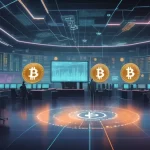XRP Options Surge to $26.9 Billion in 6 Months Amid Regulatory Clarity

XRP Options Contracts Smash $26 Billion Mark in Under Six Months
XRP options contracts have stormed the financial stage, amassing a staggering $26.9 billion in notional volume since their launch in May 2025. This explosive growth, driven by institutional heavyweights on platforms like the Chicago Mercantile Exchange (CME), signals a turning point for XRP amid newfound regulatory clarity in the U.S. and a booming crypto derivatives market.
- Historic Milestone: $26.9 billion notional volume for XRP options in less than six months.
- Institutional Wave: Over 567,000 contracts traded on CME, showcasing serious demand.
- Regulatory Boost: SEC settlement clears the path for XRP’s institutional appeal.
- Speculative Heat: Analyst eyes a $9.90 price surge despite recent volatility.
XRP Options: A Numbers Game to Watch
The stats are nothing short of striking. Since hitting the market in May 2025, XRP options have seen over 567,000 contracts traded, equivalent to roughly 9 million XRP tokens. That breaks down to an average daily trading volume of $213 million—a figure that demands attention even from the most skeptical of traditional finance folks. The CME, a cornerstone of regulated markets, has emerged as the epicenter of this activity, reporting a steady climb in institutional demand for XRP derivatives. This isn’t some fly-by-night operation on an obscure exchange; it’s a clear sign that XRP is gaining traction in spaces where compliance and oversight reign supreme, as evidenced by the massive surge in XRP options contracts. Compared to Bitcoin derivatives, which still dominate with billions in daily volume on CME, XRP’s rapid ascent in just six months hints at an altcoin catching up in the institutional race.
Ripple SEC Settlement Fuels XRP Derivatives Boom
A major catalyst behind this surge is the long-overdue regulatory clarity in the United States. For those unfamiliar with XRP’s turbulent past, here’s a quick rundown: XRP, the native token of the Ripple network, has been under a dark cloud since December 2020, when the Securities and Exchange Commission (SEC) sued Ripple Labs, alleging that XRP was an unregistered security. This legal quagmire spooked investors and sidelined institutional interest for years. The tide turned in mid-2025 with a settlement—details of which included a hefty fine for Ripple but no admission of wrongdoing—finally lifting the uncertainty. This resolution has acted like a green light for big players, who now see XRP as a safer bet without the looming threat of regulatory hammer blows. The impact? Platforms like CME have become hotbeds for XRP derivatives, as institutional confidence surges.
This isn’t just about XRP, though. The Ripple SEC settlement could set a precedent for other altcoins tangled in legal battles—think Ethereum’s staking debates or Cardano’s classification concerns. If regulators start drawing clearer lines, we might see a domino effect, with more digital assets getting the institutional nod. But let’s not pop the champagne yet; while the U.S. clarity is a win, global regulatory landscapes remain a chaotic mess, and a single policy shift elsewhere could derail this momentum.
Crypto Derivatives Market: XRP Joins the Big Leagues
Zooming out, XRP’s rise mirrors a broader trend in the crypto derivatives space. As of October 10, Open Interest (OI)—the total value of outstanding contracts yet to be settled—hit a record $9 billion across crypto options, marking a 27% increase. Think of OI as a gauge of active bets still on the table; the higher it is, the more money is in play. XRP isn’t riding solo here—Ethereum and Solana are also top performers in futures and options markets, with XRP futures alone boasting an OI of 10,100 contracts. This collective surge points to a maturing market where digital assets are no longer just speculative toys but increasingly integrated into traditional financial systems. Whether that’s a triumph for adoption or a betrayal of decentralization’s roots is a debate worth having.
Speculative Hype vs. Harsh Reality
Now, let’s tackle the crystal ball territory. Crypto analyst Javon Marks has stirred the pot with a bold prediction: XRP could rocket to $9.90, a jaw-dropping 309% leap from its current price near $2.40. Marks leans on past trends, citing XRP’s 2017 rally that peaked at $3.84, and argues that current technical patterns suggest a sharp, explosive price surge might be imminent. Tempting as that sounds, let’s ground ourselves in reality. XRP has just clawed back a modest 1.3% gain after a brutal 14.4% drop over the past month, consolidating around $2.40. Historical volatility data paints a grim picture too—XRP has seen swings of over 30% in mere days during past cycles. While a repeat of 2017’s mania isn’t impossible, banking on such predictions is closer to gambling than investing. We’re not here to peddle fantasy land nonsense; markets are swayed by macroeconomic winds, regulatory whims, and sometimes just pure chaos. Take such forecasts with a truckload of salt.
Decoding Options: What’s the Big Deal?
For those scratching their heads over “options contracts,” let’s break it down. An options contract is like buying a rain check for a concert ticket at a fixed price—you’re not obligated to buy, but you’ve got the right to if the event sells out and prices spike. In XRP’s case, it means investors can bet on or hedge against future price moves without owning the token outright. The fact that these contracts have hit $26.9 billion in volume so fast shows a sophisticated financial tool taking root in crypto. It’s not just spot trading on Binance anymore; it’s a sign that altcoins like XRP are becoming part of a more complex, mature market. This shift is exciting for adoption but also raises the stakes—missteps in leveraged plays can burn players faster than you can say “liquidation.”
Altcoins, Bitcoin, and the Maximalist Grumble
As someone who often leans toward Bitcoin maximalism, I’ll throw on the devil’s advocate hat. Bitcoin remains the unchallenged king of decentralized value storage, but XRP’s surge in derivatives underscores a truth: not every blockchain needs to be BTC. XRP, through RippleNet, targets fast, dirt-cheap cross-border payments—a niche Bitcoin doesn’t prioritize. Real-world impact? Ripple has partnered with over 300 financial institutions globally, processing transactions in seconds for fractions of a cent. This isn’t a threat to Bitcoin’s throne; it’s a complementary role in a diverse ecosystem where Ethereum drives smart contracts and Solana chases scalability. Institutional interest in XRP options proves altcoins can carve out vital spaces in this financial upheaval.
That said, maximalists have a bone to pick. XRP’s ties to Ripple Labs, which controls a significant chunk of nodes and holds a massive stash of tokens, smell of centralization—a cardinal sin in the eyes of decentralization purists. Is XRP truly a peer-to-peer rebel, or just a corporate darling in crypto clothing? It’s a fair critique, and one that keeps us from blindly cheering every altcoin win.
The Dark Side of Derivatives
Before we get too starry-eyed over XRP’s $26.9 billion milestone, let’s face the ugly underbelly of derivatives. These instruments, while powerful, are a double-edged sword. High leverage can magnify gains but also torch portfolios in a heartbeat—look no further than the 2021 crypto crash, where over-leveraged positions on exchanges like BitMEX led to billions in liquidations overnight. XRP’s volatility only heightens this risk; a sudden 20% swing isn’t a “what if,” it’s a “when.” Add to that the patchy state of global regulation—while the U.S. offers clarity, the EU’s MiCA framework is still rolling out, and Asia-Pacific policies are a Wild West. A single crackdown could spook markets and tank volumes.
Then there’s the philosophical rub. Institutional adoption, as seen on CME, is a bullish signal for crypto’s mainstreaming, but are we just trading one set of gatekeepers for another? Wall Street finally swiping right on XRP might mean bigger liquidity, but it also risks diluting the very ethos of decentralized finance we champion. Are we building a freer system, or just cozying up to the suits we once aimed to disrupt? Chew on that for a moment.
What’s Next for XRP?
Looking ahead, XRP’s trajectory hinges on a few key factors. Will institutional interest sustain, or is this a fleeting hype wave? Could further regulatory wins—or setbacks—in other regions shape its path? The derivatives market is a proving ground, but it’s also a pressure cooker. If XRP can weather volatility and Ripple continues to expand real-world use cases, we might see even deeper integration into financial systems. Yet, every step toward the mainstream brings it closer to scrutiny and potential overreach. The road ahead is anything but boring.
Key Takeaways and Burning Questions
- Why Have XRP Options Volume Hit $26.9 Billion in 2025?
Institutional demand on platforms like CME, coupled with regulatory clarity from the Ripple SEC settlement, has turbocharged trading activity in under six months. - How Does XRP Fit Into the $9 Billion Crypto Derivatives Boom?
XRP rides alongside Ethereum and Solana as a top performer, reflecting a broader wave of institutional confidence in digital assets as viable financial instruments. - Is an XRP Price Surge to $9.90 Realistic?
Analyst predictions based on past trends are intriguing but speculative; XRP’s recent volatility and market unpredictability demand cautious skepticism over blind optimism. - What Risks Lurk in XRP Derivatives Trading?
High leverage, brutal price swings, and inconsistent global regulations pose real dangers, even as institutional adoption signals a maturing crypto space. - Does XRP’s Rise Undermine Bitcoin’s Dominance?
Not quite—XRP fills a unique niche in cross-border payments, complementing rather than challenging Bitcoin’s role as the premier decentralized store of value. - Will Institutional Adoption Strengthen or Weaken Decentralized Finance?
While it drives liquidity and legitimacy, it risks aligning crypto with traditional gatekeepers, potentially straying from the core vision of financial freedom.
XRP’s sprint to $26.9 billion in options volume is a thunderous statement: this altcoin isn’t just hanging on; it’s carving a serious spot in the institutional arena. Regulatory breakthroughs have unshackled its potential, and the derivatives market can’t get enough. Yet, for every leap forward, shadows of volatility, risk, and ideological tension loom large. As advocates for decentralization and disruption, we cheer these milestones with eyes wide open to the pitfalls. XRP’s saga mirrors the broader crypto revolution—brimming with promise, laced with peril, and always keeping us on our toes. So, will this wave of adoption fortify or fracture the spirit of decentralized finance? That’s the million-XRP question.



